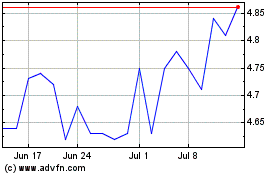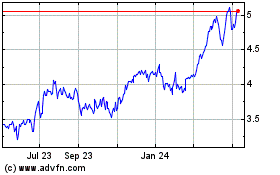By Jeannette Neumann
MADRID--Plunging oil prices, global market turmoil and
uncertainty over the makeup of Spain's next government have been
walloping Spanish banks' shares ahead of quarterly results that
investors and analysts don't expect to provide much cheer.
Investors say they will be looking at whether the banks are
boosting capital ratios to better position their balance sheets
against the turbulence. "The market is a lot more focused on
capital developments," said Iacopo Dalu, at London-based hedge fund
Amber Capital.
Overall, Spain's major domestic banks and the Spanish units of
Banco Santander SA and Banco Bilbao Vizcaya Argentaria SA are
expected to report a slight decline in net interest income in the
fourth quarter compared with the previous three months, Société
Générale SA analyst Carlos García González said. That measure of
profit is being hit by rock-bottom interest rates and shrinking
total loan volume as individuals and businesses continue to reduce
their debt.
With Spain's economy growing, provisions for bad loans at most
of the banks are likely to fall in the fourth quarter compared with
a year earlier. But investors and analysts say the decline will be
less pronounced because of the additional funds lenders are
expected to cough up to cushion against potential losses at Abengoa
SA, a major Spanish renewable energy and engineering firm that
filed for preliminary creditor protection in November.
Each bank is also required by Spanish regulators to book its
contributions to Spain's deposit guarantee fund in the fourth
quarter.
Spain's banks are reporting their 2015 annual results against an
uncertain global backdrop that has sent stock markets into a tizzy
as traders fret about Chinese growth, oil price declines and the
impact of the U.S. Federal Reserve's lifting of interest rates.
The landscape at home is also rocky, as Spaniards wait to see
which political parties will join to form a government in the wake
of December's inconclusive parliamentary election.
The governing coalition that emerges will decide whether to
continue selling off shares in Bankia SA, which is 64% owned by the
state. The privatization of Spain's No. 4 bank by market value,
which was bailed out in 2012, has been on hold since the government
sold a small share in 2014.
An independence movement in the wealthy Catalonia region has
been gathering steam, raising concern about the future of two major
banks based there, Caixabank SA and Banco de Sabadell SA.
At Santander and BBVA, investors say they will be closely
attuned to capital ratios. In the third quarter of last year,
Santander's capital ratio inched only slightly higher from the
previous three months and BBVA's fell, and both remained below
those of big-bank peers. Investors say they want to see signs of
fourth-quarter improvement.
Analysts anticipate that declines in the currencies of emerging
markets will chip away at Santander's and BBVA's profits when they
are converted into euros on the lenders' financial statements.
Emerging markets, primarily Mexico and Turkey, generate two-thirds
of BBVA's earnings. Brazil, which is in recession, contributes
about one-fifth of Santander's net profit.
"We continue to see their emerging markets operations as an area
of risk," Barclays PLC analyst Rohith Chandra-Rajan wrote in a
research report.
Capital ratio worries, emerging market currency concerns and a
7.5-billion-euro ($8.1 billion) share sale in January 2015 have
sent Santander's stock price down around 35% in the past 12 months,
Ana Botín's first full year as executive chairman.
The decline has been so great that analysts who have typically
shunned Santander shares took notice.
"We do not believe Santander has created value for its
shareholders over the past 15 years," Exane BNP Analyst Santiago
López Díaz wrote in a research report. "At its current price,
however, Santander represents a reasonable investment with a
relative margin of safety within European banking."
Santander reports fourth-quarter earnings on Wednesday.
When Caixabank announces results two days later, investors say
they will look at how much the lender writes down the value of its
stake in Spanish oil major Repsol SA.
Oil's price dive has driven down Caixabank's 9.5% direct holding
in Repsol to EUR1.1 billion from the estimated EUR2.7 billion value
the lender has assigned to the investment in financial statements,
Morgan Stanley analyst Alvaro Serrano wrote in a research
report.
"They're not going to write it down all the way to the current
market value, because that will erode too much capital," Berenberg
Bank analyst Andrew Lowe said. He expects a smaller write-down to
"appease the regulators that they're doing something about it."
He said he believes Caixabank's sale of two stakes in December
is evidence of pressure from regulators on European banks to
strengthen capital. For Caixabank, he added, "the Repsol issue is
the next step to address."
Banco Popular Español SA, which also reports on Friday, has a
hefty portfolio of nonperforming property loans that still choke
its balance sheet eight years after Spain's real-estate boom went
bust.
Investors say they would like to see Popular sell off soured
loans and foreclosures more quickly. But its low provisions on bad
debts means the bank would have to sell at a steep loss, and that
poses a dilemma: Popular could either redirect more revenue toward
provisions to boost coverage levels, eating up profits, or sell
additional shares in the market to raise funds, making current
shareholders' investments worth less.
As Popular tries to figure out its action plan, investors'
concerns have snowballed, sending the bank's shares nosediving more
than 20% since the beginning of the year.
Spain's banks are reporting their 2015 annual results against an
uncertain global backdrop that has sent stock markets into a tizzy
as traders fret about Chinese growth, oil price declines and the
impact of the U.S. Federal Reserve's lifting of interest rates.
The landscape at home is also rocky, as Spaniards wait to see
which political parties will join to form a government in the wake
of December's inconclusive parliamentary election.
The governing coalition that emerges will decide whether to
continue selling off shares in Bankia SA, which is 64%-owned by the
state. The privatization of Spain's No. 4 bank by market value,
which was bailed out in 2012, has been on hold since the government
sold down a small share in 2014.
An independence movement in the wealthy Catalonia region has
been gathering steam, raising concern about the future of two major
banks based there, Caixabank SA and Banco de Sabadell SA.
At Santander and BBVA, investors say they will be closely
attuned to capital ratios. In the third quarter of last year,
Santander's capital ratio inched only slightly higher from the
previous three months and BBVA's fell, and both remained below
those of big-bank peers. Investors say they want to see signs of
fourth-quarter improvement.
Analysts anticipate that declines in the currencies of emerging
markets will chip away at Santander's and BBVA's profit when they
are converted into euros on the lenders' financial statements.
Emerging markets, primarily Mexico and Turkey, generate two-thirds
of BBVA's earnings. Brazil, which is in recession, contributes
about one-fifth of Santander's net profit.
"We continue to see their emerging markets operations as an area
of risk," Barclays PLC analyst Rohith Chandra-Rajan wrote in a
research report.
Capital ratio worries, emerging market currency concerns and a
€7.5 billion ($8.1 billion) share sale in January 2015 have sent
Santander's stock price down around 35% in the past 12 months, Ana
Botín's first full year as executive chairman.
The decline has been so great that analysts who have typically
shunned Santander shares took notice.
"We do not believe Santander has created value for its
shareholders over the past 15 years," Exane BNP Analyst Santiago
López Díaz wrote in a research report. "At its current price,
however, Santander represents a reasonable investment with a
relative margin of safety within European banking."
Santander reports fourth-quarter earnings on Wednesday.
When Caixabank announces results two days later, investors say
they will look at how much the lender writes down the value of its
stake in Spanish oil major Repsol SA.
The oil-price dive has driven down Caixabank's 9.5% direct
holding in Repsol to €1.1 billion from the estimated €2.7 billion
value the lender has assigned to the investment in financial
statements, Morgan Stanley analyst Alvaro Serrano wrote in a
research report.
"They're not going to write it down all the way to the current
market value, because that will erode too much capital," Berenberg
Bank analyst Andrew Lowe said. He expects a smaller write down to
"appease the regulators that they're doing something about it."
He said he believes Caixabank's sale of two stakes in December
is evidence of pressure from regulators on European banks to
strengthen capital. For Caixabank, he added, "the Repsol issue is
the next step to address."
Banco Popular Español SA, which also reports on Friday, has a
hefty portfolio of nonperforming property loans that still choke
its balance sheet eight years after Spain's real-estate boom went
bust.
Investors say they would like to see Popular sell off soured
loans and foreclosures more quickly. But its low provisions on bad
debts means the bank would have to sell at a steep loss, and that
poses a dilemma: Popular could either redirect more revenue toward
provisions to boost coverage levels, eating up profits, or sell
additional shares in the market to raise funds, making current
shareholders' investments worth less.
As Popular tries to figure out its action plan, investors'
concerns have snowballed, sending the bank's shares nose-diving
more than 20% since the beginning of the year.
Write to Jeanette Neumann at jeanette.neumann@wsj.com
-0-
(MORE TO FOLLOW) Dow Jones Newswires
January 26, 2016 08:11 ET (13:11 GMT)
Copyright (c) 2016 Dow Jones & Company, Inc.
Banco Santander (NYSE:SAN)
Historical Stock Chart
From Mar 2024 to Apr 2024

Banco Santander (NYSE:SAN)
Historical Stock Chart
From Apr 2023 to Apr 2024
